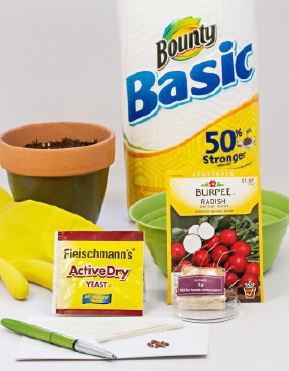





Published on Sep 12, 2023
This experiment will determine how microwave radiation affects fungi, bacteria, and plant life.
Microwave ovens blast food with high levels of energy. This results in heating up certain fats and other ingredients in food. The energy simply passes through other substances without damage. Through this experiment, we will see how this energy affects simple organisms of different types.
• Does microwave radiation destroy all life?
• Will varying lengths of radiation affect organisms differently?

1. Packet of radish seeds
2. Paper towels
3. Four small containers filled with steriliz ed potting soil
4. Four packets of bakers’ yeast
5. Four small bowls
6. Four prepared Petri dishes with agar (available from biological supply companies)
7. Steriliz ed swabs
8. Gloves
9. Microwave
10. Notepad and pen
11. Camera
1. Plant several radish seeds in a small container. Put them in a sunny, warm location. This is the control sample.
2. Place several more radish seeds on a paper towel. Microwave the seeds for five seconds.
3. Plant these seeds in another pot and place in the same location as the control group.
4 . Repeat Step 2 and 3 for two more samples, except microwave one group of seeds for fifteen seconds and the other for thirty seconds.
5. Tend the samples by watering the pots once a day and ensuring they get enough sunlight.
6. Take pictures everyday and note if and how quickly the samples grow.
7. Dump a packet of bakers’ yeast into a small bowl of warm water. Stir. This is the control sample.
8. Take note of how long it takes for the yeast to bubble up and how vigorous the reaction is. Take photos.
9. Dump another packet of bakers’ yeast onto a plate. Microwave for five seconds.
10. Mix this yeast into another bowl of warm water. Repeat Step 8.
11. Repeat steps 9 and 10 for the other packets of yeast, except microwave one sample for fifteen seconds and the other for thirty seconds.
12. Wearing gloves, use the steriliz ed swab to collect a sample of bacteria and swab it on a prepared Petri dish. Good places to find bacteria are areas where lots of people touch something, like doorknobs or faucets. Seal the dish and label it “control.” Put it in a warm, dark place. This is your control sample.
13. Swab another sample from the exact location as the control sample. Smear it on another Petri dish. Seal and label the dish. Place it in a warm, dark place.
14 . Repeat Step 13 for the other two samples.
15. Let the samples alone overnight.
16. Take one sample out (not the control) and microwave it for five seconds. Place it back in the warm, dark place.
17. Repeat Step 16 for the other two samples, except microwave one for fifteen seconds and the other for thirty seconds.
18. After another day, take out all the samples. Note how many colonies of bacteria are growing and their siz e.
19. Analyz e all this data. Does microwave radiation affect all life equally? Does time matter? How does each type of organism respond to the radiation?
Wikipedia article on microwaves